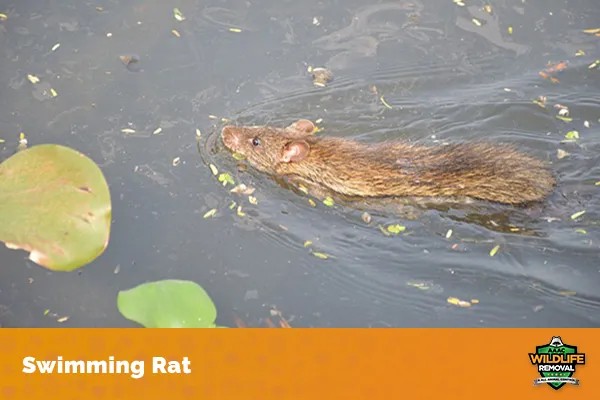At PETS.EDU.VN, we often hear the question: Can Pet Rats Swim? These intelligent and curious creatures, often underestimated, possess a surprising ability to navigate water. This article dives deep into the swimming capabilities of pet rats, offering valuable insights for rat owners and enthusiasts, plus helpful tips about rodent care, pet rat behavior, and overall well-being.
1. Understanding Rat Swimming Abilities
Rats, despite primarily being land dwellers, are naturally adept swimmers. This ability is not just limited to wild rats; pet rats also possess this skill. Their physical characteristics and natural instincts contribute to their aquatic prowess.
- Adaptable Anatomy: Rats have strong legs and a streamlined body, enabling efficient movement through water.
- Tail as a Rudder: Their long, thin tail acts as a rudder, providing balance and steering.
- Natural Instinct: Swimming is an innate behavior, often observed from a young age.
This inherent ability has allowed rats to thrive in various environments, showcasing their adaptability and resilience. They can travel and colonize new habitats and seek new food sources.
2. Can Rats Swim Underwater? The Submerged Truth
Yes, rats can swim underwater. This remarkable adaptation allows them to survive in diverse environments.
- Breath-Holding Capacity: Rats can hold their breath for up to three minutes.
- Survival Tactic: Swimming underwater allows rats to escape predators.
- Exploration: This skill enables them to explore aquatic environments and find new food sources.
While they are not aquatic animals, their ability to submerge is a significant survival advantage.
3. Swimming Skills: How Good Are Rats?
Rats are surprisingly proficient swimmers, exceeding expectations for their size and terrestrial lifestyle. Their swimming capability is due to several factors:
- Powerful Legs: Strong hind legs propel them through the water.
- Streamlined Form: A sleek body shape reduces water resistance.
- Insulating Fur: Dense fur provides warmth in cold water.
Their swimming ability is integral to their survival, helping them adapt and thrive in various habitats.
4. The Mechanics of Rat Swimming
Rats use a combination of physical attributes and techniques to navigate water effectively.
- Tail Steering: Tails act as rudders, providing directional control.
- Leg Propulsion: Hind legs push against the water, generating forward motion.
- Buoyancy: Fur helps them stay afloat, conserving energy.
These coordinated movements allow rats to swim with ease and agility.
5. Do Rats Enjoy Water? Exploring Their Preferences
Whether rats enjoy water is subjective, but their behavior suggests a tolerance, if not a preference, for swimming. It is important to note that their enjoyment does not matter.
- Survival Necessity: They swim out of necessity, such as finding food or escaping danger.
- Exploratory Behavior: Rats may swim to investigate new environments.
- Cooling Mechanism: Water helps regulate their body temperature in hot conditions.
For pet rats, swimming can be a form of enrichment, providing exercise and mental stimulation.
6. Distance Capabilities: How Far Can Rats Swim?
Rats are capable of swimming remarkable distances, showcasing their endurance and determination.
- Long-Distance Swimmers: They can swim up to a mile at a time.
- Extended Treading: Rats can tread water for up to three days.
- Survival Imperative: This ability allows them to cross large bodies of water in search of new habitats or resources.
Their swimming range underscores their resourcefulness and adaptability.
7. Can Rats Swim in the Sea? A Salty Challenge
Rats can swim in seawater, though it presents additional challenges compared to freshwater.
- Saltwater Tolerance: They can tolerate saltwater for short periods.
- Energy Expenditure: Swimming in saltwater requires more energy due to increased buoyancy and density.
- Dehydration Risk: Saltwater ingestion can lead to dehydration, limiting their swimming duration.
Despite these challenges, rats have been known to cross significant stretches of ocean, demonstrating their resilience.
8. The Urban Legend: Rats in Toilets
The idea of rats swimming up toilets is a common fear, and while rare, it is possible.
- Physical Feats: Rats are capable of climbing and swimming up drainpipes.
- Access Points: They can enter homes through sewer systems and access toilets.
- Preventive Measures: Maintaining proper sanitation and sealing entry points can minimize this risk.
Although uncommon, this scenario highlights the rat’s resourcefulness and adaptability.
9. Variations in Swimming Ability Among Rat Species
Swimming capabilities can differ among rat species.
| Species | Swimming Ability | Habitat Preferences |
|---|---|---|
| Brown Rat | Excellent | Urban areas, sewers, waterways |
| Black Rat | Good | Coastal regions, ships, forests |
| Norway Rat | Very Good | Farms, urban areas, near water |
| Roof Rat | Average | Attics, trees, high places |




Brown rats are typically better swimmers than black rats, with variations depending on habitat and lifestyle.
10. Pet Rats and Swimming: What You Need to Know
Pet rats retain their natural swimming instincts and can enjoy water-based activities under supervision.
- Natural Instincts: Pet rats have swimming instincts inherited from their wild ancestors.
- Supervised Swimming: Provide shallow water under supervision for safe exploration.
- Enrichment: Swimming can be a fun and stimulating activity for pet rats.
Ensure water is clean and at a comfortable temperature to prevent health issues.
11. Creating a Safe Swimming Environment for Your Pet Rat
To ensure your pet rat enjoys swimming safely, follow these guidelines:
- Shallow Water: Use a shallow container to prevent drowning.
- Supervision: Always supervise your rat while it is swimming.
- Clean Water: Use clean, lukewarm water to avoid infections.
- Towel Drying: Gently dry your rat with a towel after swimming to prevent chills.
- Avoid Soap: Do not use soap unless specifically recommended by a veterinarian, as it can irritate their skin.
12. The Benefits of Swimming for Pet Rats
Swimming offers several benefits for pet rats:
- Exercise: It provides a full-body workout, promoting physical health.
- Mental Stimulation: Exploring water can stimulate their minds and reduce boredom.
- Bonding: Supervised swimming can strengthen the bond between you and your pet.
- Hygiene: Helps to keep your pet rat clean.
13. Potential Risks and Precautions
While swimming can be beneficial, it also poses some risks:
- Drowning: Always supervise to prevent accidental drowning.
- Hypothermia: Ensure the water is warm and dry your rat thoroughly afterward.
- Infections: Use clean water and monitor for signs of skin or ear infections.
- Stress: Some rats may not enjoy swimming, so never force them.
14. Recognizing Signs of Distress
Watch for these signs that your rat is uncomfortable or stressed while swimming:
- Excessive Vocalization: Unusual squeaking or chattering.
- Frantic Movements: Desperate attempts to escape the water.
- Lethargy: Reduced activity or reluctance to move.
- Hiding: Seeking shelter or trying to hide from the water.
If you notice any of these signs, immediately remove your rat from the water.
15. Integrating Swimming into Your Rat’s Routine
Introduce swimming gradually and make it a positive experience:
- Start Slow: Begin with short sessions and gradually increase the duration.
- Positive Reinforcement: Use treats and praise to reward their participation.
- Comfortable Environment: Ensure the water is at a comfortable temperature and the environment is calm.
- Respect Boundaries: Never force your rat to swim if they are unwilling.
16. Expert Opinions on Rat Swimming
Veterinarians and rat experts offer valuable insights into rat swimming:
- Dr. Emily Carter, Veterinarian: “Swimming can be a great form of exercise for rats, but supervision is crucial to prevent accidents.”
- John Smith, Rat Behaviorist: “Rats swim out of necessity and habit, not usually enjoyment. Enrichment is more the reason.”
- Lisa Johnson, Rat Breeder: “Pet rats have swimming instincts, but owners should introduce water gradually and make it a positive experience.”
17. Common Myths and Misconceptions
There are several myths about rat swimming abilities:
- Myth: Rats love swimming.
- Fact: Rats swim out of necessity, but do not love to swim.
- Myth: All rats are excellent swimmers.
- Fact: Swimming abilities vary among species.
- Myth: Rats can swim indefinitely.
- Fact: Rats have limitations and can tire easily.
18. How Rats Use Swimming for Survival
Swimming is a critical survival skill for rats:
- Escape from Predators: It allows them to evade land-based predators.
- Access to Resources: They can reach food and water sources in aquatic environments.
- Territory Expansion: Swimming enables them to colonize new areas.
- Navigation: It helps them navigate complex environments, like sewers and waterways.
19. Case Studies: Rats in Aquatic Environments
Real-world examples demonstrate the rat’s swimming prowess:
- Case Study 1: Rats colonizing islands by swimming long distances.
- Case Study 2: Rats surviving floods by swimming through submerged areas.
- Case Study 3: Rats using swimming to access food in urban waterways.
These examples highlight their adaptability and resilience.
20. The Role of Swimming in Rat Evolution
Swimming has played a significant role in rat evolution:
- Adaptation: It has allowed them to adapt to diverse environments.
- Dispersal: Swimming has facilitated their spread across continents.
- Survival: It has enhanced their ability to survive in challenging conditions.
Their aquatic abilities have contributed to their success as a species.
21. Advanced Swimming Techniques
Rats can employ advanced swimming techniques:
- Underwater Navigation: Using bubbles as landmarks.
- Surface Diving: Quickly submerging to avoid detection.
- Group Swimming: Coordinating movements to cross large bodies of water.
These techniques demonstrate their intelligence and adaptability.
22. The Future of Rat Research: Aquatic Abilities
Future research may focus on:
- Genetic Studies: Identifying genes responsible for swimming abilities.
- Behavioral Analysis: Studying how rats learn and adapt to aquatic environments.
- Conservation Efforts: Understanding how swimming affects their survival in changing ecosystems.
This research will provide valuable insights into rat behavior and ecology.
23. Swimming as a Part of a Holistic Care Routine
Integrate swimming into a comprehensive care plan:
- Balanced Diet: Provide a nutritious diet to support their energy needs.
- Regular Exercise: Encourage physical activity to maintain their health.
- Mental Enrichment: Offer stimulating activities to prevent boredom.
- Veterinary Care: Ensure regular check-ups to address any health concerns.
A holistic approach ensures their overall well-being.
24. Alternatives to Swimming for Pet Rat Enrichment
If your rat dislikes swimming, consider these alternatives:
- Playpens: Create a safe space for exploration and play.
- Tunnels and Mazes: Provide opportunities for mental and physical stimulation.
- Puzzle Toys: Challenge their problem-solving skills with interactive toys.
- Social Interaction: Spend quality time bonding with your rat through gentle handling and play.
These alternatives can enhance their quality of life.
25. Swimming Safety Checklist
Before allowing your rat to swim, review this checklist:
- [ ] Shallow water container.
- [ ] Clean, lukewarm water.
- [ ] Constant supervision.
- [ ] Towel for drying.
- [ ] Safe, calm environment.
This checklist ensures a safe and enjoyable experience for your pet.
26. The Impact of Pollution on Rat Swimming
Pollution can negatively affect rat swimming:
- Contaminated Water: Pollutants can cause skin irritations and infections.
- Reduced Buoyancy: Oil and chemicals can affect their fur’s ability to provide buoyancy.
- Health Issues: Ingesting polluted water can lead to internal health problems.
- Habitat Degradation: Pollution can destroy aquatic habitats, reducing their access to resources.
Protecting aquatic environments is crucial for their well-being.
27. Resources for Further Learning
Explore these resources to learn more about rat swimming:
- Veterinary Journals: Scientific articles on rat physiology and behavior.
- Rat Associations: Organizations dedicated to rat care and conservation.
- Online Forums: Communities where rat owners share tips and experiences.
- Educational Websites: Reputable sources providing information on rat swimming abilities.
28. Real-Life Stories: Pet Rats and Their Swimming Adventures
Share inspiring stories of pet rats who enjoy swimming:
- Story 1: A rat who overcame its fear of water with patient encouragement.
- Story 2: A rat who uses swimming as therapy for anxiety.
- Story 3: A rat who enjoys swimming competitions with its owner.
These stories demonstrate the positive impact of swimming on their lives.
29. The Connection Between Swimming and Rat Intelligence
Swimming highlights rat intelligence:
- Problem-Solving: They must navigate and adapt to aquatic environments.
- Learning: Rats can learn to associate swimming with positive experiences.
- Adaptability: They can adjust their swimming techniques based on conditions.
- Memory: Rats can remember routes and locations in the water.
Their swimming abilities showcase their cognitive skills.
30. Addressing Concerns About Rats Swimming in Urban Areas
Address public concerns about rats swimming in urban areas:
- Public Health: Educate about the risks of disease transmission and prevention measures.
- Environmental Impact: Highlight the importance of sanitation and waste management.
- Humane Solutions: Promote humane methods of rat control and relocation.
- Community Engagement: Encourage community involvement in addressing rat-related issues.
By addressing these concerns, we can promote coexistence and minimize conflicts.
31. Rat Swimming in Different Climates
Rats adapt to different climates through swimming:
- Cold Climates: They use their dense fur to insulate against cold water.
- Hot Climates: Swimming helps them regulate their body temperature.
- Temperate Climates: They swim to access resources and escape predators.
- Arid Climates: Rats may swim in limited water sources to survive.
Their swimming abilities enable them to thrive in various environments.
32. DIY Swimming Setups for Pet Rats
Create a DIY swimming setup using:
- Plastic Container: A shallow container filled with water.
- Ramp: A small ramp for easy access.
- Toys: Floating toys for enrichment.
- Supervision: Always supervise your rat.
Ensure the setup is safe, clean, and comfortable for your pet.
33. The History of Rat Swimming Studies
Explore the history of rat swimming studies:
- Early Research: Initial studies focused on their physiological adaptations.
- Behavioral Studies: Later research examined their swimming behavior and learning abilities.
- Modern Studies: Current research explores their genetic and evolutionary adaptations.
These studies have provided valuable insights into rat swimming.
34. The Social Aspects of Swimming for Pet Rats
Some rats enjoy swimming with companions:
- Bonding: Swimming together can strengthen social bonds.
- Play: Rats may engage in playful activities in the water.
- Competition: Some rats may compete for toys or attention.
Supervise group swimming to prevent aggression or accidents.
35. Debunking Myths About Rat Hygiene and Swimming
Address common misconceptions about rat hygiene:
- Myth: Rats are dirty animals.
- Fact: Rats are clean and groom themselves regularly.
- Myth: Swimming spreads diseases.
- Fact: Clean water and proper hygiene minimize the risk.
- Myth: Rats cannot swim in clean water.
- Fact: Rats can swim in clean or unclean water, but should only swim in clean water for hygiene reasons.
36. How PETS.EDU.VN Supports Responsible Rat Ownership
At PETS.EDU.VN, we provide comprehensive resources for rat owners:
- Expert Articles: Informative articles on rat care, health, and behavior.
- Community Forums: A platform for rat owners to connect and share information.
- Veterinary Directory: A directory of trusted veterinarians specializing in rat care.
- Product Reviews: Reviews of essential rat care products, from cages to toys.
We are committed to supporting responsible rat ownership and improving the lives of these amazing animals.
37. Conclusion: Embrace the Aquatic Side of Your Pet Rat
Pet rats possess a remarkable ability to swim, offering numerous benefits for their physical and mental well-being. By providing a safe and enriching swimming environment, you can enhance their quality of life and strengthen your bond. Remember to supervise their activities, respect their boundaries, and seek expert advice when needed. At PETS.EDU.VN, we are dedicated to providing the information and support you need to be a responsible and loving rat owner. Explore our resources and join our community to discover more about these intelligent and fascinating animals.
38. Frequently Asked Questions (FAQ)
1. Can all pet rats swim?
Yes, most pet rats have the natural ability to swim, though some may be more comfortable in the water than others.
2. Is it safe for my pet rat to swim in a pool?
No, pools often contain chemicals that can be harmful to rats. It’s safer to provide a small container of clean water.
3. How often should I let my rat swim?
Swimming frequency depends on your rat’s preferences and health. Start with short sessions once or twice a week and adjust as needed.
4. What is the ideal water temperature for rat swimming?
The water should be lukewarm, around 80-85°F (26-29°C), to prevent hypothermia.
5. Can rats swim in saltwater?
Rats can swim in saltwater for short periods, but it’s not ideal due to the risk of dehydration.
6. How long can a rat hold its breath underwater?
Rats can hold their breath for up to three minutes.
7. What are the signs of a rat drowning?
Signs include frantic movements, struggling to stay afloat, and exhaustion.
8. How do I clean a swimming container for my rat?
Use mild soap and water, and rinse thoroughly to remove any residue.
9. Can swimming help with rat obesity?
Yes, swimming is a great form of exercise that can help manage weight and improve overall fitness.
10. Are there any health conditions that would prevent a rat from swimming?
Rats with respiratory issues, skin infections, or open wounds should avoid swimming. Consult with a veterinarian for guidance.
For more detailed information and expert advice on rat care, visit PETS.EDU.VN today.
(CTA) Ready to dive deeper into the world of pet rat care? Visit PETS.EDU.VN for more expert tips, detailed guides, and a supportive community of pet lovers. Whether you’re seeking advice on creating the perfect swimming environment or understanding your rat’s unique behaviors, we have the resources you need. Contact us at 789 Paw Lane, Petville, CA 91234, United States, or WhatsApp at +1 555-987-6543. Your journey to becoming the best rat owner starts here Visit pets.edu.vn